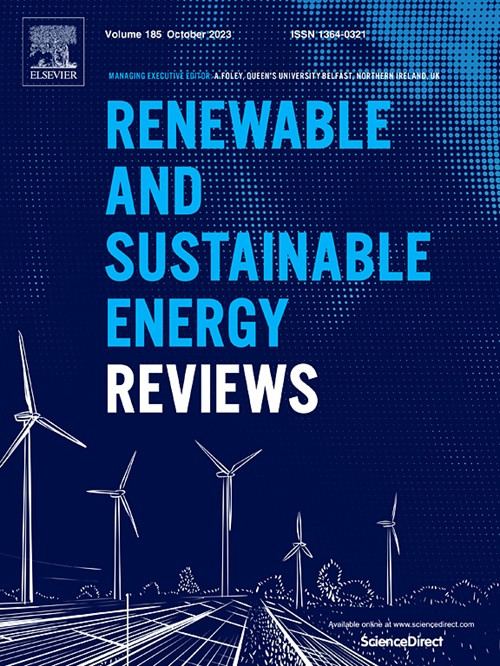Advanced encapsulation strategies for high-temperature molten salt: Synthesis methods and performance enhancement
IF 16.3
1区 工程技术
Q1 ENERGY & FUELS
引用次数: 0
Abstract
In the pursuit of a global paradigm shift in energy structure and carbon neutrality objectives, high-temperature thermal energy storage technologies have garnered significant attention due to their high efficiency and cost advantages. Latent heat storage utilizing molten salts demonstrates notable advantages including high energy density and isothermal phase change characteristics, playing crucial roles in industrial waste heat recovery, renewable energy utilization, and energy supply-demand balance regulation. Nevertheless, practical implementation is hindered by critical limitations, primarily molten salt leakage and equipment corrosion. Encapsulation technology has emerged as an effective mitigation strategy, enhancing system safety and longevity. This review systematically examines the latest advancements in molten salt encapsulation technology, focusing on three primary methods: melt infiltration, capsule method, and mixed sintering. Moreover, this review summarizes the impact of encapsulation strategies on molten salt phase change materials (PCMs) performance, including thermophysical properties, mechanical characteristics, cycling stability, and economic viability. Additionally, emerging research directions such as biomimetic design, multifunctional composite materials, and industrial waste utilization are extensively explored, highlighting their applications and potential advantages in molten salt encapsulation. Finally, the technical characteristics and advantages of encapsulated molten salts were analyzed across various configurations, including heat exchangers, finned systems, and cascaded phase change material (PCM) systems. The work aspires to inspire more innovative research, thereby driving technological breakthroughs in high-temperature energy storage applications of molten salt composite PCMs.
高温熔盐的先进封装策略:合成方法和性能增强
在追求全球能源结构范式转变和碳中和目标的过程中,高温热能储存技术因其高效率和成本优势而备受关注。熔盐潜热蓄能具有高能量密度和等温相变特性等显著优势,在工业余热回收、可再生能源利用和能源供需平衡调节等方面发挥着重要作用。然而,实际实施受到关键限制的阻碍,主要是熔盐泄漏和设备腐蚀。封装技术已成为一种有效的缓解策略,提高了系统的安全性和寿命。本文系统地综述了熔盐封装技术的最新进展,重点介绍了熔盐渗透、胶囊法和混合烧结三种主要方法。此外,本文综述了封装策略对熔盐相变材料(PCMs)性能的影响,包括热物理性能、机械特性、循环稳定性和经济可行性。并对仿生设计、多功能复合材料、工业废弃物利用等新兴研究方向进行了深入探讨,突出了其在熔盐封装中的应用和潜在优势。最后,分析了封装熔盐在换热器、翅片系统和级联相变材料(PCM)系统等不同配置下的技术特点和优势。这项工作渴望激发更多的创新研究,从而推动熔盐复合相变材料高温储能应用的技术突破。
本文章由计算机程序翻译,如有差异,请以英文原文为准。
求助全文
约1分钟内获得全文
求助全文
来源期刊

Renewable and Sustainable Energy Reviews
工程技术-能源与燃料
CiteScore
31.20
自引率
5.70%
发文量
1055
审稿时长
62 days
期刊介绍:
The mission of Renewable and Sustainable Energy Reviews is to disseminate the most compelling and pertinent critical insights in renewable and sustainable energy, fostering collaboration among the research community, private sector, and policy and decision makers. The journal aims to exchange challenges, solutions, innovative concepts, and technologies, contributing to sustainable development, the transition to a low-carbon future, and the attainment of emissions targets outlined by the United Nations Framework Convention on Climate Change.
Renewable and Sustainable Energy Reviews publishes a diverse range of content, including review papers, original research, case studies, and analyses of new technologies, all featuring a substantial review component such as critique, comparison, or analysis. Introducing a distinctive paper type, Expert Insights, the journal presents commissioned mini-reviews authored by field leaders, addressing topics of significant interest. Case studies undergo consideration only if they showcase the work's applicability to other regions or contribute valuable insights to the broader field of renewable and sustainable energy. Notably, a bibliographic or literature review lacking critical analysis is deemed unsuitable for publication.
 求助内容:
求助内容: 应助结果提醒方式:
应助结果提醒方式:


